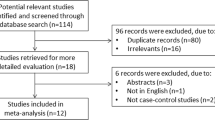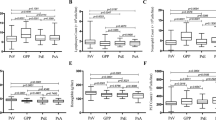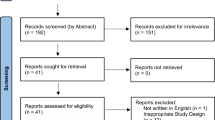Abstract
In this study, we aimed to investigate the association of platelet-to-lymphocyte ratio (PLR) and neutrophil-to-lymphocyte ratio (NLR) with clinical manifestations in patients with systemic sclerosis (SSc). We conducted a cross-sectional analysis of data collected from a cohort study of 114 female patients with SSc and of 304 age-matched, healthy, female controls recruited from a tertiary rheumatology center. Patients with digital ulcers (DU) included those with either active or healed ulcers. Interstitial lung disease (ILD) was diagnosed on detection of diffuse ground-glass opacity or pulmonary fibrosis on chest X-ray or on high-resolution computed tomography. Patients with SSc had significantly higher PLR and NLR than ealthy controls. Of 114 patients with SSc, 35 (30.7%) and 54 (47.4%) patients had DU (active: 12, healed: 23) and ILD, respectively. PLR and NLR in SSc patients with concurrent DU or ILD were significantly higher than that in those without these respective complications. The PLR (OR = 1.008, 95% CI 1.002–1.015), but not the NLR, was independently associated with the presence of DU in SSc patients, based on multivariable logistic regression models. Additionally, both PLR (OR = 1.008, 95% CI 1.001–1.014) and NLR (OR = 1.515, 95% CI 1.066–2.155) correlated independently with the presence of ILD. However, both the PLR and NLR showed no significant association with the modified Rodnan skin score, pulmonary arterial hypertension, and gastrointestinal involvement. Our results suggest that PLR and NLR could be considered as potential biomarkers of DU and ILD, in patients with SSc.

Similar content being viewed by others
References
Varga J, Abraham D (2007) Systemic sclerosis: a prototypic multisystem fibrotic disorder. J Clin Invest 117(3):557–567. https://doi.org/10.1172/JCI31139
Marangoni RG, Varga J, Tourtellotte WG (2016) Animal models of scleroderma: recent progress. Curr Opin Rheumatol 28(6):561–570. https://doi.org/10.1097/BOR.0000000000000331
Beyer C, Schett G, Distler O, Distler JH (2010) Animal models of systemic sclerosis: prospects and limitations. Arthritis Rheum 62(10):2831–2844. https://doi.org/10.1002/art.27647
van den Hombergh WMT, Knaapen-Hans HKA, van den Hoogen FHJ, Carreira P, Distler O, Hesselstrand R, Hunzelmann N, Vettori S, Fransen J, Vonk MC (2020) Prediction of organ involvement and survival in systemic sclerosis patients in the first 5years from diagnosis. J Scleroderma Relat Disord 5(1):57–65. https://doi.org/10.1177/2397198319869564
Matucci-Cerinic M, Kahaleh B, Wigley FM (2013) Review: evidence that systemic sclerosis is a vascular disease. Arthritis Rheum 65(8):1953–1962. https://doi.org/10.1002/art.37988
Korman B (2019) Evolving insights into the cellular and molecular pathogenesis of fibrosis in systemic sclerosis. Transl Res 209:77–89. https://doi.org/10.1016/j.trsl.2019.02.010
Brown M, O'Reilly S (2019) The immunopathogenesis of fibrosis in systemic sclerosis. Clin Exp Immunol 195(3):310–321. https://doi.org/10.1111/cei.13238
Doridot L, Jeljeli M, Chene C, Batteux F (2019) Implication of oxidative stress in the pathogenesis of systemic sclerosis via inflammation, autoimmunity and fibrosis. Redox Biol 25:101122. https://doi.org/10.1016/j.redox.2019.101122
Gasparyan AY, Ayvazyan L, Mukanova U, Yessirkepov M, Kitas GD (2019) The platelet-to-lymphocyte ratio as an inflammatory marker in rheumatic diseases. Ann Lab Med 39(4):345–357. https://doi.org/10.3343/alm.2019.39.4.345
Lee JS, Kim NY, Na SH, Youn YH, Shin CS (2018) Reference values of neutrophil-lymphocyte ratio, lymphocyte-monocyte ratio, platelet-lymphocyte ratio, and mean platelet volume in healthy adults in South Korea. Medicine (Baltimore) 97(26):e11138. https://doi.org/10.1097/MD.0000000000011138
Paquissi FC (2016) The role of inflammation in cardiovascular diseases: the predictive value of neutrophil-lymphocyte ratio as a marker in peripheral arterial disease. Ther Clin Risk Manag 12:851–860. https://doi.org/10.2147/TCRM.S107635
Angkananard T, Anothaisintawee T, McEvoy M, Attia J, Thakkinstian A (2018) Neutrophil lymphocyte ratio and cardiovascular disease risk: a systematic review and meta-analysis. Biomed Res Int 2018:2703518. https://doi.org/10.1155/2018/2703518
Wang Q, Ma J, Jiang Z, Ming L (2018) Prognostic value of neutrophil-to-lymphocyte ratio and platelet-to-lymphocyte ratio in acute pulmonary embolism: a systematic review and meta-analysis. Int Angiol 37(1):4–11. https://doi.org/10.23736/S0392-9590.17.03848-2
Liu CC, Ko HJ, Liu WS, Hung CL, Hu KC, Yu LY, Shih SC (2019) Neutrophil-to-lymphocyte ratio as a predictive marker of metabolic syndrome. Medicine (Baltimore) 98(43):e17537. https://doi.org/10.1097/MD.0000000000017537
Ye Z, Ai X, Liao Z, You C, Cheng Y (2019) The prognostic values of neutrophil to lymphocyte ratio for outcomes in chronic obstructive pulmonary disease. Medicine (Baltimore) 98(28):e16371. https://doi.org/10.1097/MD.0000000000016371
Lee HN, Kim YK, Kim GT, Ahn E, So MW, Sohn DH, Lee SG (2019) Neutrophil-to-lymphocyte and platelet-to-lymphocyte ratio as predictors of 12-week treatment response and drug persistence of anti-tumor necrosis factor-alpha agents in patients with rheumatoid arthritis: a retrospective chart review analysis. Rheumatol Int 39(5):859–868. https://doi.org/10.1007/s00296-019-04276-x
Unlu M, Arslan Z (2015) The relation between neutrophil-lymphocyte ratio and endothelial dysfunction. Angiology 66(7):694. https://doi.org/10.1177/0003319715584879
Eraldemir FC, Musul M, Duman AE, Oztas B, Baydemir C, Hulagu S (2016) The relationship between neutrophil/lymphocyte and platelet/lymphocyte ratios with oxidative stress in active Crohn's disease patients. Hippokratia 20(4):368–373
Kulaksizoglu B, Kulaksizoglu S (2016) Relationship between neutrophil/lymphocyte ratio with oxidative stress and psychopathology in patients with schizophrenia. Neuropsychiatr Dis Treat 12:1999–2005. https://doi.org/10.2147/NDT.S110484
Atilla N, Yildirim Cetin G, Balkarli A (2016) Association of neutrophil/lymphocyte ratio with the degree ofinterstitial lung disease in systemic sclerosis. Turk J Med Sci 46(6):1871–1874. https://doi.org/10.3906/sag-1601-87
Yayla ME, Ilgen U, Okatan IE, UsluYurteri E, Torgutalp M, Kelesoglu Dincer AB, Aydemir Guloksuz EG, Sezer S, Turgay TM, Kinikli G, Ates A (2020) Association of simple hematological parameters with disease manifestations, activity, and severity in patients with systemic sclerosis. Clin Rheumatol 39(1):77–83. https://doi.org/10.1007/s10067-019-04685-0
van den Hoogen F, Khanna D, Fransen J, Johnson SR, Baron M, Tyndall A, Matucci-Cerinic M, Naden RP, Medsger TA Jr, Carreira PE, Riemekasten G, Clements PJ, Denton CP, Distler O, Allanore Y, Furst DE, Gabrielli A, Mayes MD, van Laar JM, Seibold JR, Czirjak L, Steen VD, Inanc M, Kowal-Bielecka O, Muller-Ladner U, Valentini G, Veale DJ, Vonk MC, Walker UA, Chung L, Collier DH, Ellen Csuka M, Fessler BJ, Guiducci S, Herrick A, Hsu VM, Jimenez S, Kahaleh B, Merkel PA, Sierakowski S, Silver RM, Simms RW, Varga J, Pope JE (2013) 2013 classification criteria for systemic sclerosis: an American college of rheumatology/European league against rheumatism collaborative initiative. Ann Rheum Dis 72(11):1747–1755. https://doi.org/10.1136/annrheumdis-2013-204424
LeRoy EC, Black C, Fleischmajer R, Jablonska S, Krieg T, Medsger TA Jr, Rowell N, Wollheim F (1988) Scleroderma (systemic sclerosis): classification, subsets and pathogenesis. J Rheumatol 15(2):202–205
Clements P, Lachenbruch P, Siebold J, White B, Weiner S, Martin R, Weinstein A, Weisman M, Mayes M, Collier D et al (1995) Inter and intraobserver variability of total skin thickness score (modified Rodnan TSS) in systemic sclerosis. J Rheumatol 22(7):1281–1285
Hughes M, Tracey A, Bhushan M, Chakravarty K, Denton CP, Dubey S, Guiducci S, Muir L, Ong V, Parker L, Pauling JD, Prabu A, Rogers C, Roberts C, Herrick AL (2018) Reliability of digital ulcer definitions as proposed by the UK Scleroderma Study Group: a challenge for clinical trial design. J Scleroderma Relat Disord 3(2):170–174. https://doi.org/10.1177/2397198318764796
Khimdas S, Harding S, Bonner A, Zummer B, Baron M, Pope J (2011) Associations with digital ulcers in a large cohort of systemic sclerosis: results from the Canadian Scleroderma Research Group registry. Arthritis Care Res (Hoboken) 63(1):142–149. https://doi.org/10.1002/acr.20336
Park EK, Lee SG, Kim BH, Park JH, Lee S, Kim GT (2016) Insulin resistance is associated with digital ulcer in patients with systemic sclerosis. Clinical and experimental rheumatology 34 Suppl 100 (5):85–91
Park EK, Park JH, Kweon SM, Kim GT, Lee SG (2017) Vitamin D deficiency is associated with digital ulcer but not with atherosclerosis or arterial stiffness in patients with systemic sclerosis: a pilot study. Clin Rheumatol 36(6):1325–1333. https://doi.org/10.1007/s10067-017-3622-9
Kim E, Lee HN, Kim YK, Kim GT, So MW, Ahn E, Sohn DH, Lee SG (2019) Increased serum uric acid levels are associated with digital ulcers in patients with systemic sclerosis. Rheumatol Int 39(2):255–263. https://doi.org/10.1007/s00296-019-04240-9
Moon KW, Lee SS, Lee YJ, Jun JB, Yoo SJ, Ju JH, Chang SH, Choi IA, Kang TY, Lee EB, Lee SG (2018) Clinical and laboratory characteristics and mortality in Korean patients with systemic sclerosis: a nationwide multicenter retrospective cohort study. J Rheumatol 45(9):1281–1288. https://doi.org/10.3899/jrheum.171443
Hughes M, Allanore Y, Chung L, Pauling JD, Denton CP, Matucci-Cerinic M (2020) Raynaud phenomenon and digital ulcers in systemic sclerosis. Nat Rev Rheumatol. https://doi.org/10.1038/s41584-020-0386-4
Ntelis K, Solomou EE, Sakkas L, Liossis SN, Daoussis D (2017) The role of platelets in autoimmunity, vasculopathy, and fibrosis: implications for systemic sclerosis. Semin Arthritis Rheum 47(3):409–417. https://doi.org/10.1016/j.semarthrit.2017.05.004
Scherlinger M, Guillotin V, Truchetet ME, Contin-Bordes C, Sisirak V, Duffau P, Lazaro E, Richez C, Blanco P (2018) Systemic lupus erythematosus and systemic sclerosis: all roads lead to platelets. Autoimmun Rev 17(6):625–635. https://doi.org/10.1016/j.autrev.2018.01.012
Gasparyan AY, Ayvazyan L, Pretorius E, Kitas GD (2014) Platelets in rheumatic diseases: friend or foe? Curr Pharm Des 20(4):552–566. https://doi.org/10.2174/138161282004140213143843
Maugeri N, Rovere-Querini P, Baldini M, Baldissera E, Sabbadini MG, Bianchi ME, Manfredi AA (2014) Oxidative stress elicits platelet/leukocyte inflammatory interactions via HMGB1: a candidate for microvessel injury in sytemic sclerosis. Antioxid Redox Signal 20(7):1060–1074. https://doi.org/10.1089/ars.2013.5298
Yang W, Wang X, Zhang W, Ying H, Xu Y, Zhang J, Min Q, Chen J (2017) Neutrophil-lymphocyte ratio and platelet-lymphocyte ratio are 2 new inflammatory markers associated with pulmonary involvement and disease activity in patients with dermatomyositis. Clin Chim Acta 465:11–16. https://doi.org/10.1016/j.cca.2016.12.007
Chen Q, Chen DY, Xu XZ, Liu YY, Yin TT, Li D (2019) Platelet/lymphocyte, lymphocyte/monocyte, and neutrophil/lymphocyte ratios as biomarkers in patients with rheumatoid arthritis and rheumatoid arthritis-associated interstitial lung disease. Med Sci Monit 25:6474–6481. https://doi.org/10.12659/MSM.916583
Perelas A, Silver RM, Arrossi AV, Highland KB (2020) Systemic sclerosis-associated interstitial lung disease. Lancet Respir Med 8(3):304–320. https://doi.org/10.1016/S2213-2600(19)30480-1
Bagnato G, Harari S (2015) Cellular interactions in the pathogenesis of interstitial lung diseases. Eur Respir Rev 24(135):102–114. https://doi.org/10.1183/09059180.00003214
Zhao G, Liu N, Wang S, Guo J, Song X, Qi Y, Qiu W, Lv J (2020) Prognostic significance of the neutrophil-to-lymphocyte and platelet-to-lymphocyte ratio in patients with metastatic gastric cancer. Medicine (Baltimore) 99(10):e19405. https://doi.org/10.1097/MD.0000000000019405
Casciola-Rosen L, Wigley F, Rosen A (1997) Scleroderma autoantigens are uniquely fragmented by metal-catalyzed oxidation reactions: implications for pathogenesis. J Exp Med 185(1):71–79. https://doi.org/10.1084/jem.185.1.71
Servettaz A, Goulvestre C, Kavian N, Nicco C, Guilpain P, Chereau C, Vuiblet V, Guillevin L, Mouthon L, Weill B, Batteux F (2009) Selective oxidation of DNA topoisomerase 1 induces systemic sclerosis in the mouse. J Immunol 182(9):5855–5864. https://doi.org/10.4049/jimmunol.0803705
van Caam A, Vonk M, van den Hoogen F, van Lent P, van der Kraan P (2018) Unraveling SSc pathophysiology. Myofibroblast Front Immunol 9:2452. https://doi.org/10.3389/fimmu.2018.02452
Khanna D, Furst DE, Clements PJ, Allanore Y, Baron M, Czirjak L, Distler O, Foeldvari I, Kuwana M, Matucci-Cerinic M, Mayes M, Medsger T Jr, Merkel PA, Pope JE, Seibold JR, Steen V, Stevens W, Denton CP (2017) Standardization of the modified Rodnan skin score for use in clinical trials of systemic sclerosis. J Scleroderma Relat Disord 2(1):11–18. https://doi.org/10.5301/jsrd.5000231
Funding
None.
Author information
Authors and Affiliations
Contributions
AK: study design, data collection and analysis and writing manuscript, YKK: data interpretation, GTK: data interpretation and revision of manuscript, MWS: data interpretation and revision of manuscript, EA: data interpretation, DHS: data interpretation and revision of manuscript, SGL: study design, data analysis and interpretation, writing manuscript and coordination of entire study. All authors approved the final manuscript as submitted and agree to be accountable for all aspects of the work.
Corresponding author
Ethics declarations
Conflicts of interest
The authors have declared no conflicts of interest.
Ethical approval
All procedure of the current study was approved by the Research and Ethical Review Board of the Pusan National University Hospital (IRB no. 1906-021-080 and approval date 2019-06-19) and was conducted in accordance with the principles within the Declaration of Helsinki.
Informed consent
Written informed consent was obtained from all enrolled study participants.
Additional information
Publisher's Note
Springer Nature remains neutral with regard to jurisdictional claims in published maps and institutional affiliations.
Electronic supplementary material
Below is the link to the electronic supplementary material.
296_2020_4604_MOESM1_ESM.tif
Supplementary figure 1. Correlations of platelet to lymphocyte ratio and neutrophil to lymphocyte ratio values with modified Rodnan skin score (A and B), C-reactive proteins (C and D) and erythrocyte sedimentation rate (E and F) in patients with systemic sclerosis (TIF 924 kb)
Rights and permissions
About this article
Cite this article
Kim, A., Kim, Y., Kim, GT. et al. Platelet-to-lymphocyte ratio and neutrophil-to-lymphocyte ratio as potential makers for digital ulcers and interstitial lung disease in patients with systemic sclerosis: cross-sectional analysis of data from a prospective cohort study. Rheumatol Int 40, 1071–1079 (2020). https://doi.org/10.1007/s00296-020-04604-6
Received:
Accepted:
Published:
Issue Date:
DOI: https://doi.org/10.1007/s00296-020-04604-6




